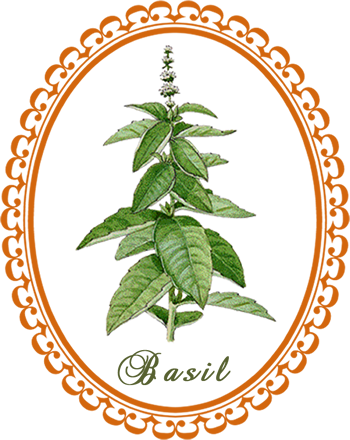
Basil: is both calming and cheering to the spirits. It is an ideal herb to use in the winter when your spirits are low ...
Common Names: Common Basil, Sweet Basil
Botanical Name: Ocimum basilicum
Family: Lamiaceae
Plant Type: Tender annual
Parts Used: Leaves
Once native to India and Persia only, and still a sacred herb to the Hindus, basil is an annual plant much used now in Mediterranean cookery.
Description: It grows up to 2 feet in height, and its one drawback is that it must be raised from seed or seedling each year. It likes a rich moist soil with plenty of sun. You can buy various types of basil besides the "sweet" variety, the other most popular being "bush" basil. All posses the same properties, however. The herb grows with a square stem in section; smooth, slightly toothed, oval leaves, which give off a strong clove fragrance when crushed; and white, pink or red whorls of flowers which nestle in the axils of the leaves (where the leaf joins the stem).
Cultivation:
Growing basil from seed: basil seed is very fine and can take weeks to germinate. If you throw it straight on the ground the weeds may smother it before it has a chance to grow, so you may want to start it in punnets or pots.
Spread some seed very thinly and only cover with soil very lightly. Make sure the soil is neither too wet nor let it dry out. Plant your basil out when it's big enough to handle. Basil grows better and faster in the ground.
Growing basil from cuttings: just take a tip cutting off any plant at any time of the year. Cut off all the leaves except for the tiny ones that are emerging at the top and stick the thing in a pot. Keep it in partial shade and keep it moist. Basil cuttings root very quickly. Once the little basil plant is actively growing again you can plant it out.
Plant in full sun in moist, well-drained soil. It prefers a pH of about 6.0.
Harvesting: You can start harvesting basil very early. In fact, you should. Basil should be picked constantly. You can harvest individual leaves, but the best way to harvest basil is to take off all the tips. Start doing this when your basil is about 15 cm high. It encourages more branching and more growth, but most importantly it prevents flowering.
That's right. Unfortunately, if you have only a few basil plants, you should prevent them from flowering for as long as possible. Once a basil plant goes to flower it puts all its energy into the blooms and seeds and does not produce any more leaves. And then it dies.
Culinary Uses: Basil is the traditional pizza herb and is widely used in Italian cooking. Chop and add fresh to just about anything. It is the main component of pesto, a condiment made from basil, garlic, pine nuts, and olive oil. Use the leaves whole in salads. It does not dry well, and stores best in oils, vinegars, or frozen.
Basil Magick
Love. Wealth. Exorcism. Protection. Flying.
Gender: Masculine
Planet: Mars
Element: Fire
Dieties: Vishnu, Erzulie
To mend a lover's quarrel, place sprigs of basil around the bedroom.
The scent of fresh basil causes sympathy between two people.
Add basil to love incenses and sachets, or rub it into your skin as a natural love perfume.
Carry some basil in your pocket to attract wealth, or put it in the cash register to attract customers.
Love divinations with basil: Place two fresh basil leaves upon a live coal. If they lie where you put them and burn quickly to ashes, the relationship will be harmonious. If they crackle and jump as they burn, the relationship will be disturbed by quarrels. If the leaves fly apart with fierce crackling, the relationship is volatile and undesirable.
Herbal Healing with Basil
Cosmetic Uses: Basil is used in hair rinses to bring luster to hair.
Medicinal Actions: Abortifacient, analgesic, antibacterial, antidepressant, antiseptic, antispasmodic, antistress, antivenomous, aperitive, aphrodisiac, blood purifier, carminative, cephalic, diaphoretic, digestive, emmenagogue, estrogenic, expectorant, febrifuge, galactagogue, insect repellent, insecticide, laxative, nervine, refreshing, restorative, sedative, stimulant (adrenal glands; facilitates childbirth), stomachic, sudorific, tonic (nerves), uplifting, vermifuge
Medicinal Uses: Basil is used as a digestive aid and has a slight sedative action. Fresh basil leaves and basil oil both have antibacterial properties, and can actually be used to clean surfaces of infectious disease. Basil leaves applied topically to wounds may also eliminate bacterial infections. Ingesting basil as a culinary herb or supplement can also give the body an ability to combat viral infections, including colds, flu, and herpes-family viruses-- much like its distant cousin, echinacea.
One of the primary medicinal uses of basil comes from BCP, or (E)-beta-caryophyllene, a natural anti-inflammatory compound also found in oregano and medicinal cannabis. BCP found in basil may offer an alternative to medical marijuana, because it offers the same anti-inflammatory effects without the mental and neurological side-effects of illicit drugs. BCP in basil is believed to combat bowel inflammation and rheumatoid arthritis. Source Here
Contraindications: Pregnant women should use basil with caution
Body Care with Basil
- To reduce the itching of an insect bite, rub a fresh basil leaf onto the area
- To clear the head during a head cold, use a basil steam inhalation until symptoms subside.
Inhalation: 2 tablespoons dried basil or a handful of fresh basil leaves in 5 litres (6 cups) of steaming water.
Basil Tea: Infuse 1 teaspoon dried herb in 1 covered cup boiling water. Strain, and flavor with honey if desired. Up to 1 or 2 cups a day may be taken.
Source: The Essential Herbs Handbook by Lesley Bremness
If you appreciate the information provided,
please help keep this website running. Blessings!
© 2008-2025 aromaworx.ca. All rights reserved.

